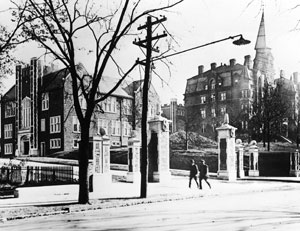
University of Tennessee at Chattanooga
In 1886 the Methodist Episcopal Church, North founded Chattanooga University. Strife within the church over educational policy in the South soon undermined Chattanooga University and led to its consolidation in 1889 with a rival school, Grant Memorial University in Athens, Tennessee.
In 1889 the consolidated school adopted the name U. S. Grant University. Its administrative center, undergraduate college, and preparatory department were removed to Athens, leaving the Chattanooga campus with makeshift specialty programs in business, law, medicine, and theology. Internal problems survived the reorganization. Trustees of the debt-ridden school sued its president to stop him from selling one-half of the Chattanooga campus in 1890, and the general level of teaching remained of subcollegiate grade as the number of collegiate students steadily declined to thirty-nine out of a total enrollment of 247 in 1898.
Faculty members predicted that the school was “approaching dissolution,” but the president who took office in 1898 refused to join the death watch. John H. Race, a Northern Methodist clergyman without prior experience in college administration, transformed the fractious pseudo-university into a genuine liberal arts college. Race eliminated the preparatory and specialty programs and concentrated on elevating academic standards in the undergraduate college, which reopened in Chattanooga in 1904 and six years later gained membership in the Association of Colleges and Secondary Schools of the Southern States. He raised $750,000 in capital funds, including large sums from steel baron Andrew Carnegie and the Rockefeller-funded General Education Board. He also won independence from direct control by the Northern Methodist Church. In 1909 the church transferred ownership of the school property to local trustees, who thereupon changed the name to the University of Chattanooga.
The complete severance of denominational ties came in 1935 when the university board dropped the requirement that two-thirds of its membership be Northern Methodists. Six years earlier, Alexander Guerry had become the first southerner, layman, and non-Methodist to serve as university president. Under Guerry and his successors, the University of Chattanooga pursued a policy of vigorous community outreach. Town-gown relations, once chilly, grew cordial as services to the community multiplied, notably in adult education, the performing arts, and degree programs preparing students for jobs in local business. By 1945 the institution had forged an alliance with the commercial-civic elite of Chattanooga that sustained the private undergraduate college well into the 1960s.
A perplexing challenge arose in 1968 when a public institution, the University of Tennessee, announced plans to build a four-year college in Chattanooga. Faced with the choice of competing head-on with the state university or joining forces with it, trustees of the Chattanooga institution merged it with the University of Tennessee to become the University of Tennessee at Chattanooga. An unusual feature of the merger agreement was the creation of the University of Chattanooga Foundation, which retains and manages the endowment once held by the University of Chattanooga. Income from the endowment provides scholarships, distinguished professorships, and special programs not usually found on the campus of a state-supported institution. In 1996 the UC Foundation endowment stood at $65 million.
Since the merger, degree programs have expanded to include one hundred at the undergraduate level and forty-six at the master’s level. Enrollment has climbed from 2,300 students in 1968 to 9,000 in 2001. African Americans were first admitted as undergraduates in 1965 and comprised 13 percent of the student body in 1996. Most students live within a fifty-mile radius of the campus, and many are first-generation college enrollees. With a reputation for quality in undergraduate teaching and support from both private and public sources, the University of Tennessee at Chattanooga aspires to eminence as a metropolitan university dedicated to serving the Chattanooga region.
Suggested Reading
Gilbert E. Govan and James W. Livingood, The University of Chattanooga: Sixty Years (1947); Linda Walker, ed., UTC: A Pictorial Review (1986)



